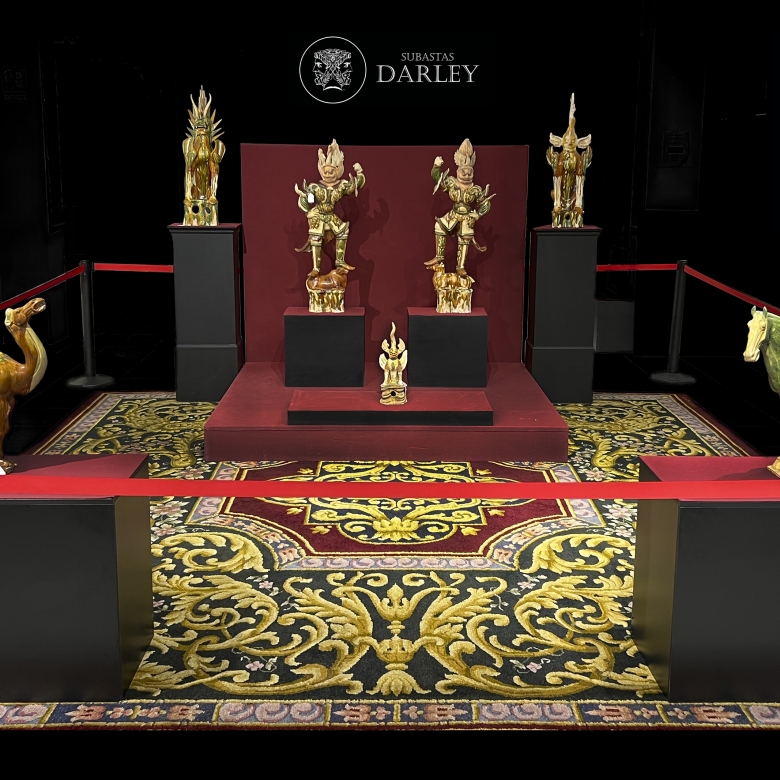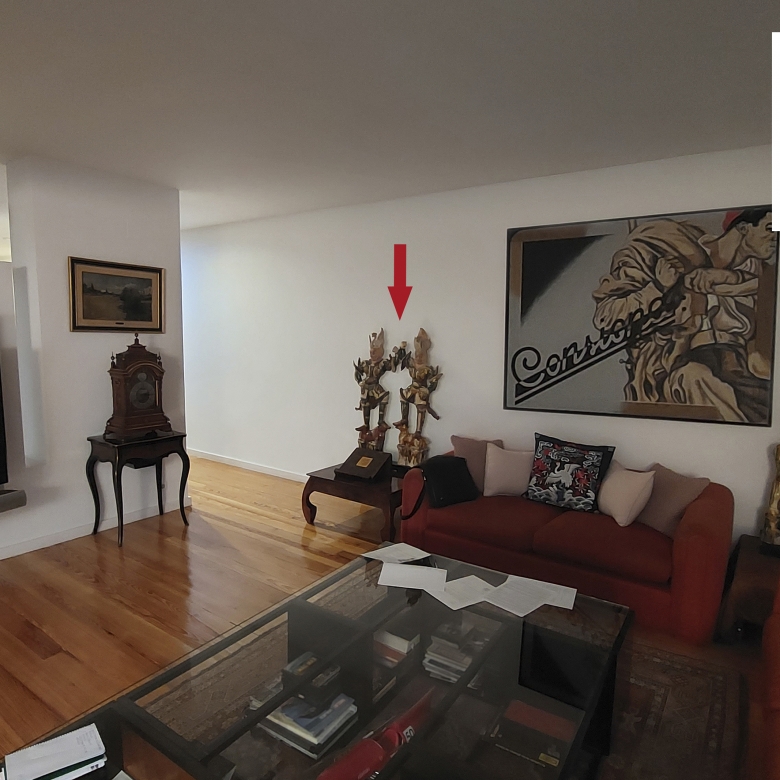ASIAN ART AUCTION 29 DECEMBER 2022
Pair of large figures "Earth Spirits", Tang Dynasty (618 - 906)
Press 'Program an autobid'in order to confirm
A pair of figures modelled in kaolin ware, decorated in amber, green and cream-coloured 'sancai' glaze (三彩) and polychrome. It is hollow on the inside.
It depicts two tomb-protecting beasts, known as 'earth spirits' or 'zhenmushou', with features intended to demonstrate ferocity. These creatures are characteristically winged and have the forelegs of horses. They sit on a pedestal, with their hind legs bent, while keeping their front legs stretched out, raising their muscular, puffy chests. One of them has a humanized face with large ears and traces of polychrome. The other reflects the qualities of a beast: lion-like features, a wrinkled nose and an open mouth showing its teeth. Both exhibit exuberant antlers, and pointed crests. The facial features and decorative details, such as flowers, feathers, scales and manes, are delicately modelled.
As was customary, they are covered with striking tricoloured glazes superimposed on the fired pottery. These were applied irregularly and during firing they flow spontaneously, leave traces, mix and create different patterns in each case. The aim is to achieve a harmonious union of colours, which is obtained by a combination of chance and the potter's control of the technique.
Height left: 87 cm; Height right: 80 cm
The height of these figures and their state of preservation are exceptional, considering their age. It shows some restorations, although preserving its integrity.
Documentation:
Left figure:
Accompanied by a report and "Thermoluminescence Test" carried out by the TL Laboratory of the Autonomous University of Madrid (UAM). Report no.: 10042P, year 2004.
Right figure:
Accompanied by a report and "Thermoluminescence Test" carried out by the TL Laboratory of the Autonomous University of Madrid (UAM). Report no.: 10041P, year 2004.
The results confirm, from the extraction of material from the piece, compatibility with ceramic materials fired in the Tang dynasty period.
Provenance:
Spanish private collection.
This important private collection comes from a successful national and international construction and investment businessman who lived in different parts of Spain and the South of France. This part of the collection, exhibited exclusively for the first time at auction, focuses on Chinese ceramics from the Tang dynasty and is a collection of museum quality pieces. The family's tradition of travel dates back to the success of an ancestor who in the 1930s travelled to Manila, Shanghai, Cairo, Havana, etc., practising the sport of "cesta punta", and in particular, motivated by an interest in discovering different cultures, which led them to build up a large collection. In general, their interest in art is such that their collection includes pieces of both Asian and European origin.
The acquisition of the collection began in the 1990s and was built up during years of study in Madrid and on various trips to Paris, New York, Hong Kong, Spain and Germany; at reputable antique dealers such as "Arch Angel" in Hong Kong and international auctions such as Nagel. To this end, specialists have also collaborated in the selection, study and verification of the pieces, as can be seen in the accompanying documentation: invoices, studies and reports.
Additional information:
The function of these figures was to protect the tombs and accompany the deceased, and they were endowed with visual qualities for this purpose. The first such figures were seen in the tombs of Li Feng, Prince of Guo (622-675). Large 'sancai' figures of better quality were included in the tombs of royalty and nobility, both in the Chang'an capital of the time and in the city of Luoyang. During the Tang dynasty, Henan province was one of the richest places in the empire.
They are decorated with brightly coloured glazes that can be seen on many pieces from the Tang period, from the 7th century onwards. The type of glaze was called "Sancai" (三彩) because of the use of three low-temperature firing colours. They are coloured by metallic oxides of copper, iron and manganese. They are an evolution of the tradition of Han and Wei single-coloured wares. The material used to make these ceramics is kaolin with fine white texture and glossy glazes, representing the peak of the development of coloured glazed ceramics in China. The result is a magnificent and dazzling artistic effect. An example would be the Luoyang Museum's "洛陽博物館" figure set and the Shaanxi History Museum's "陕西历史博物馆".
Zhenmushou' were part of the grave goods in the tombs of the nobility, along with other figures such as scholars, horses, camels and other mythological beings. The number and size of the pieces determined the rank of the deceased. The arrangement of the pieces was intended to reflect aspects of society, such as military and civilian aspects, with Buddhist religious concepts. An example of a funerary ensemble can be found in the British Museum under the number "1936,1012.221".






































